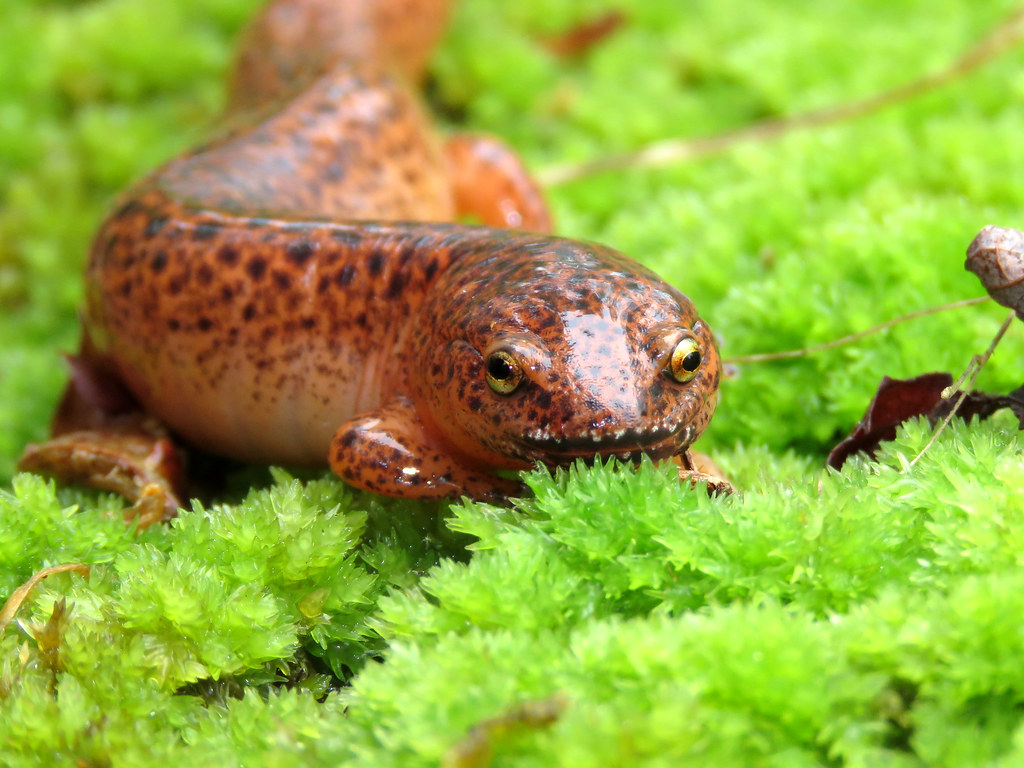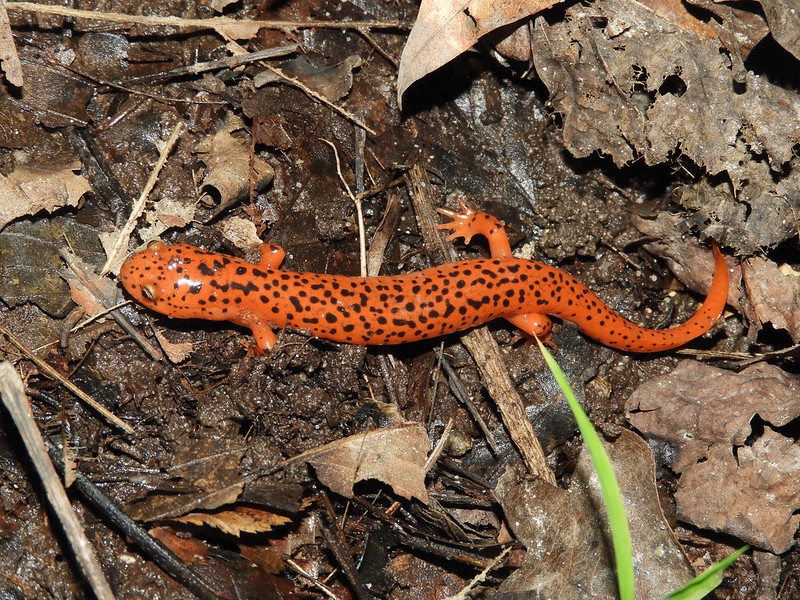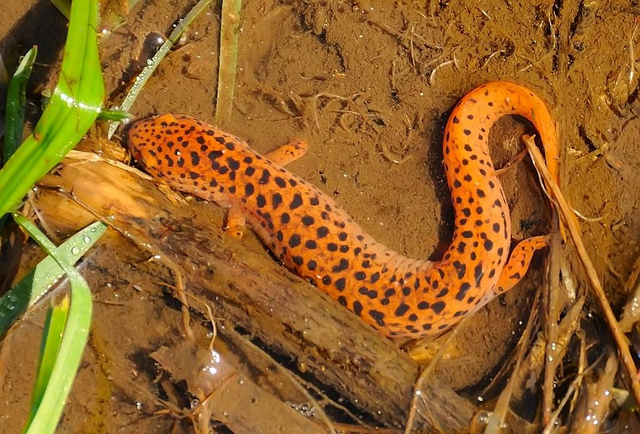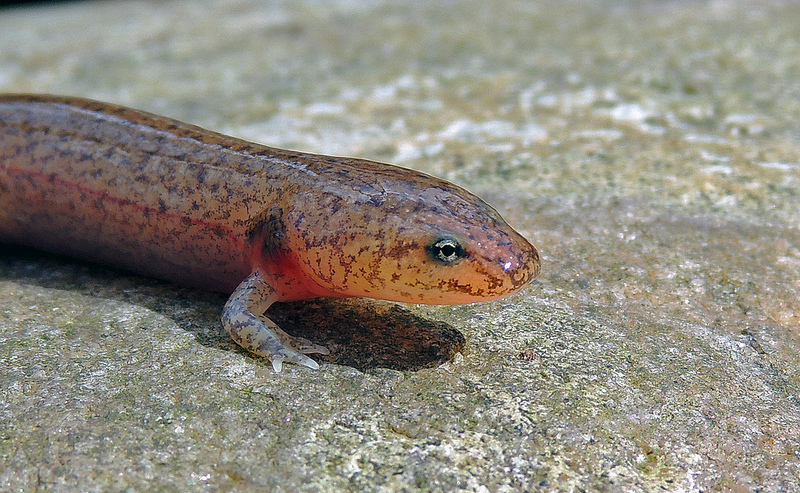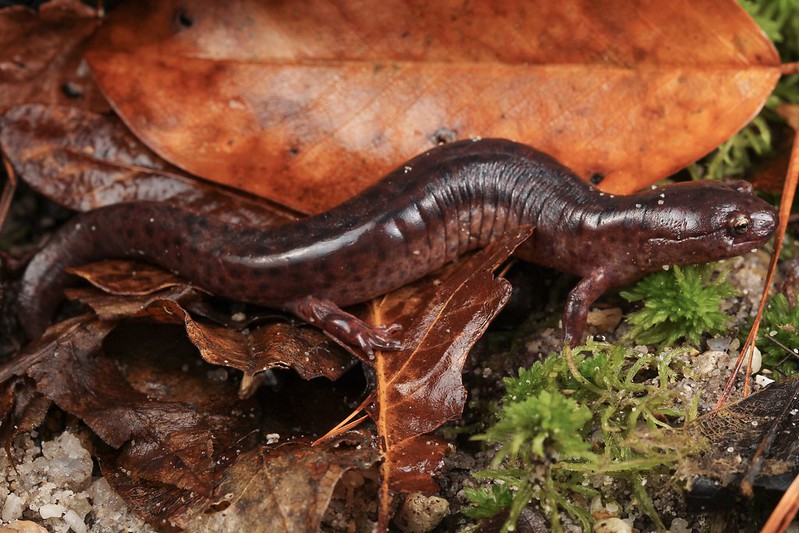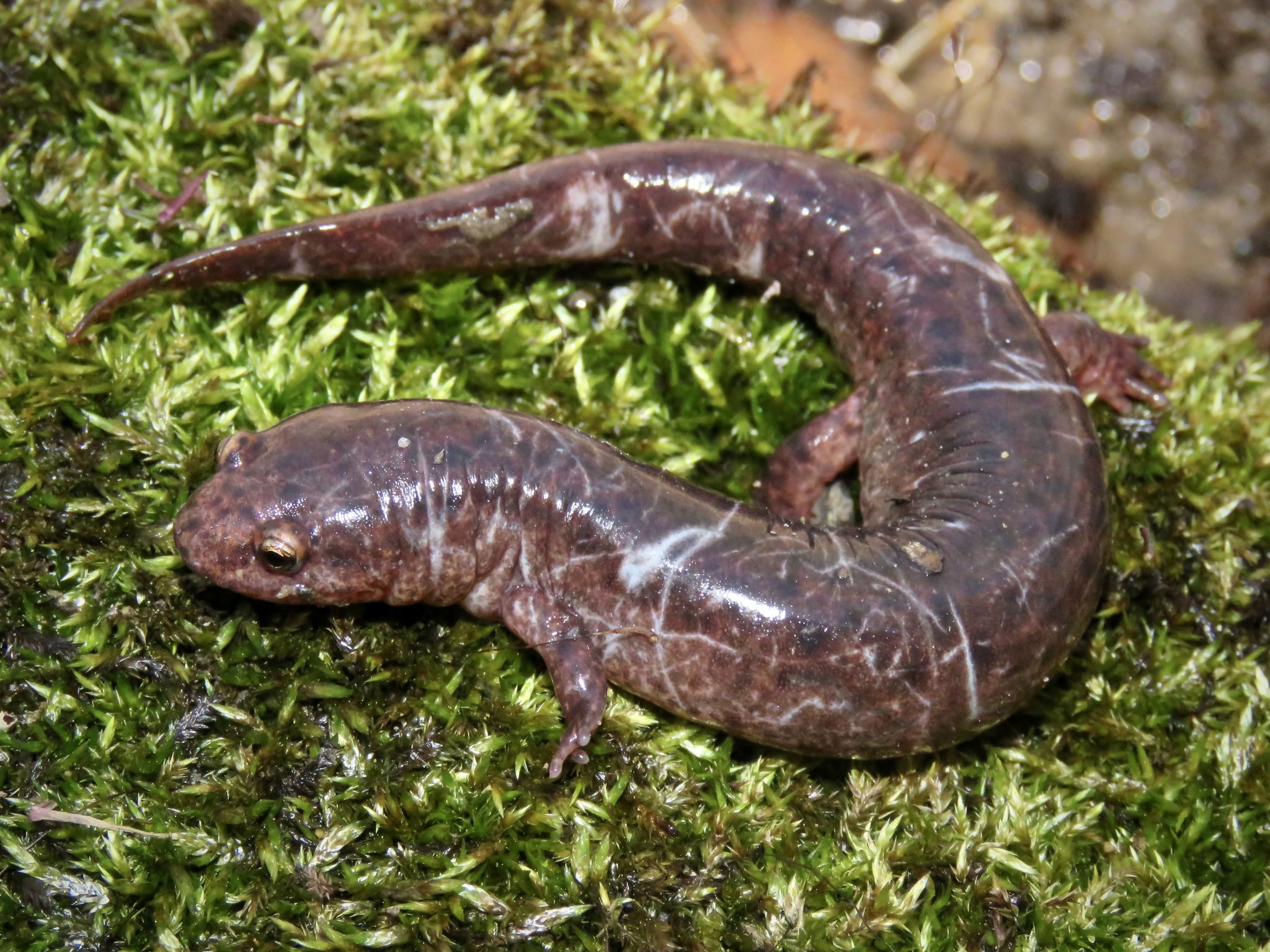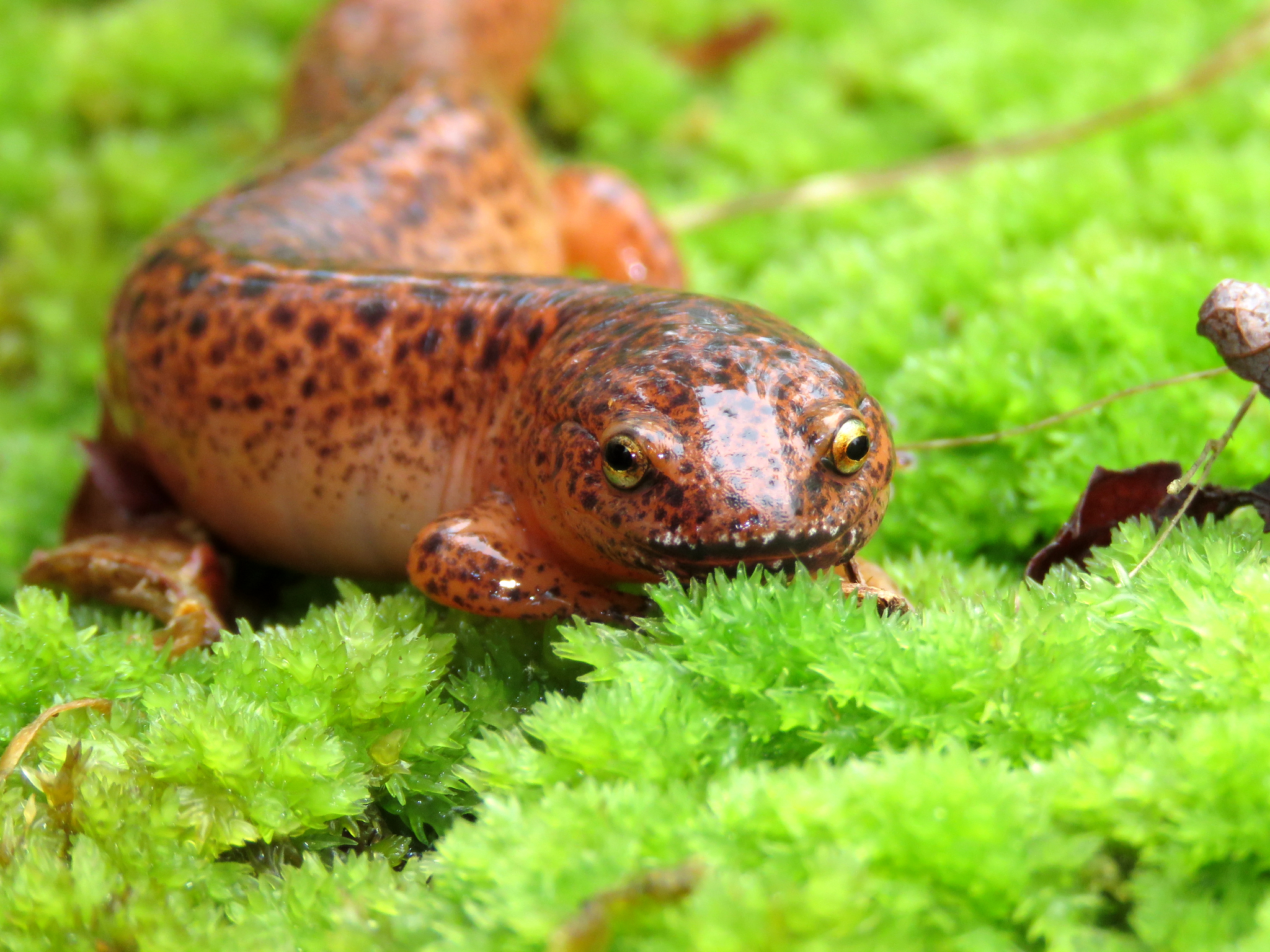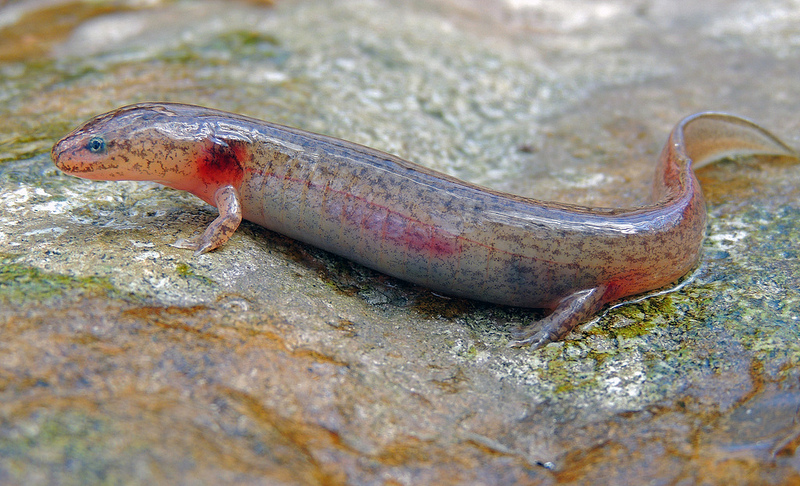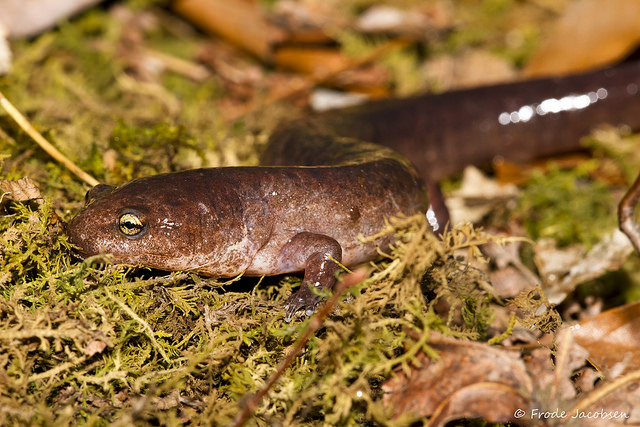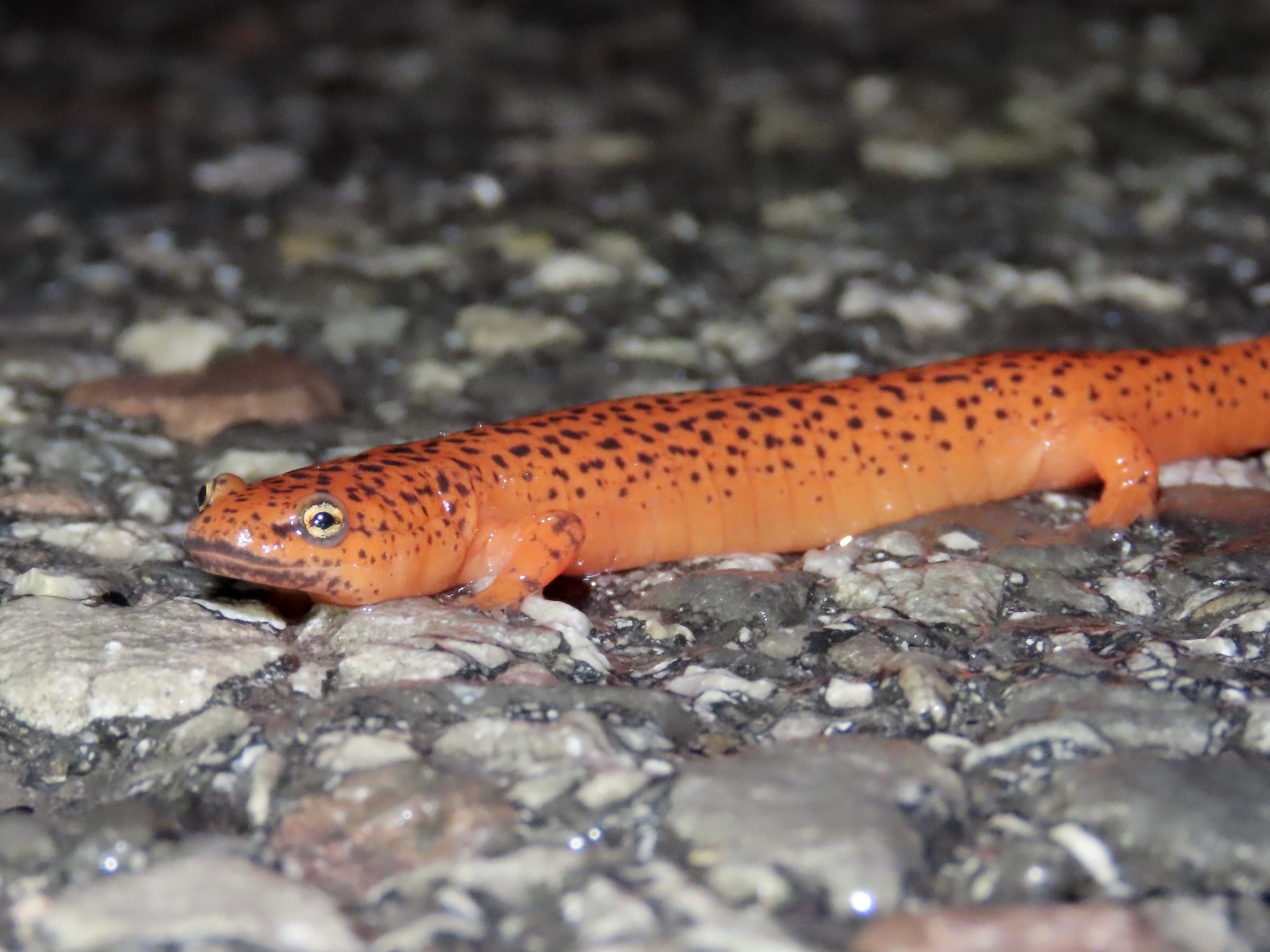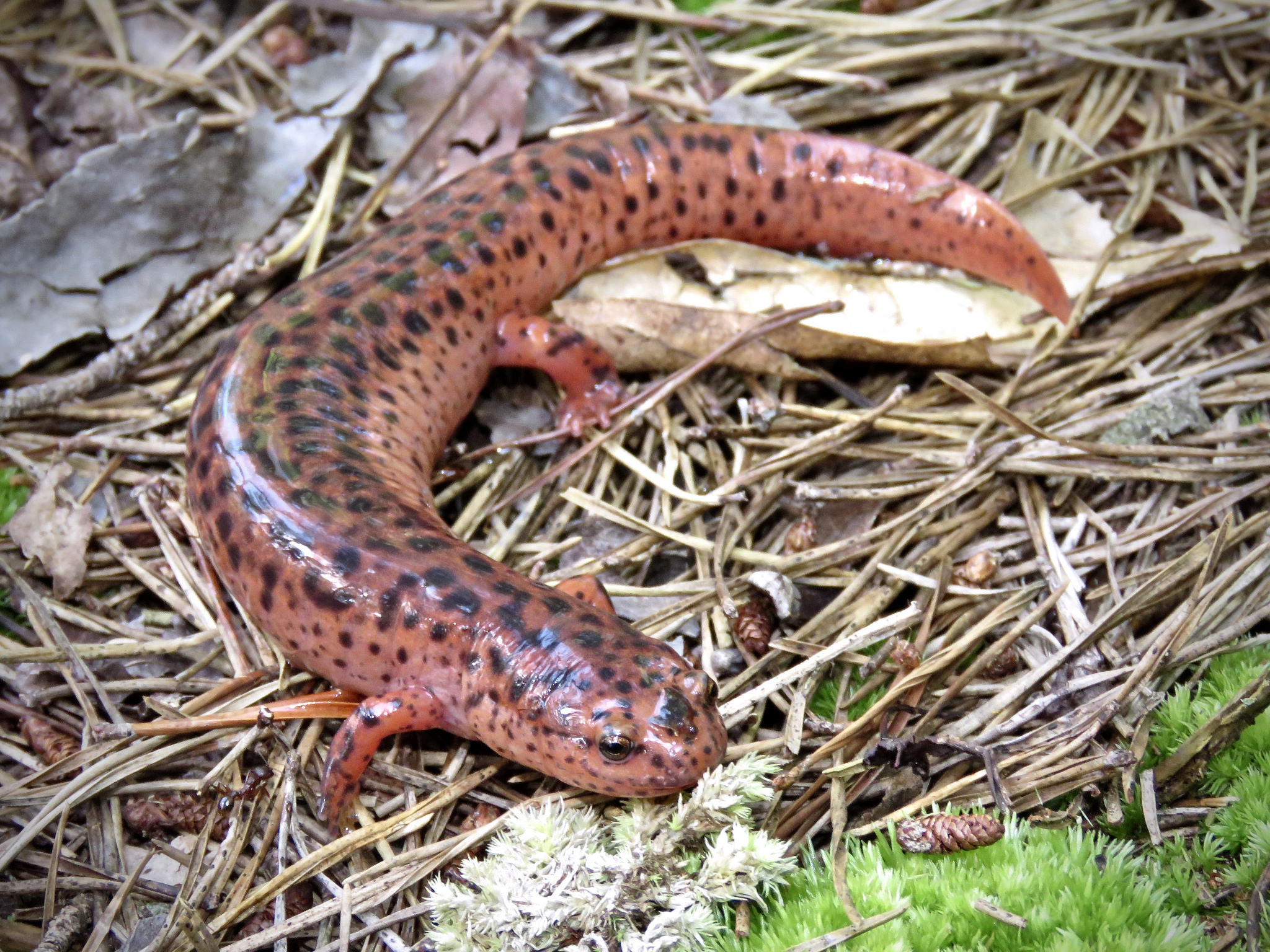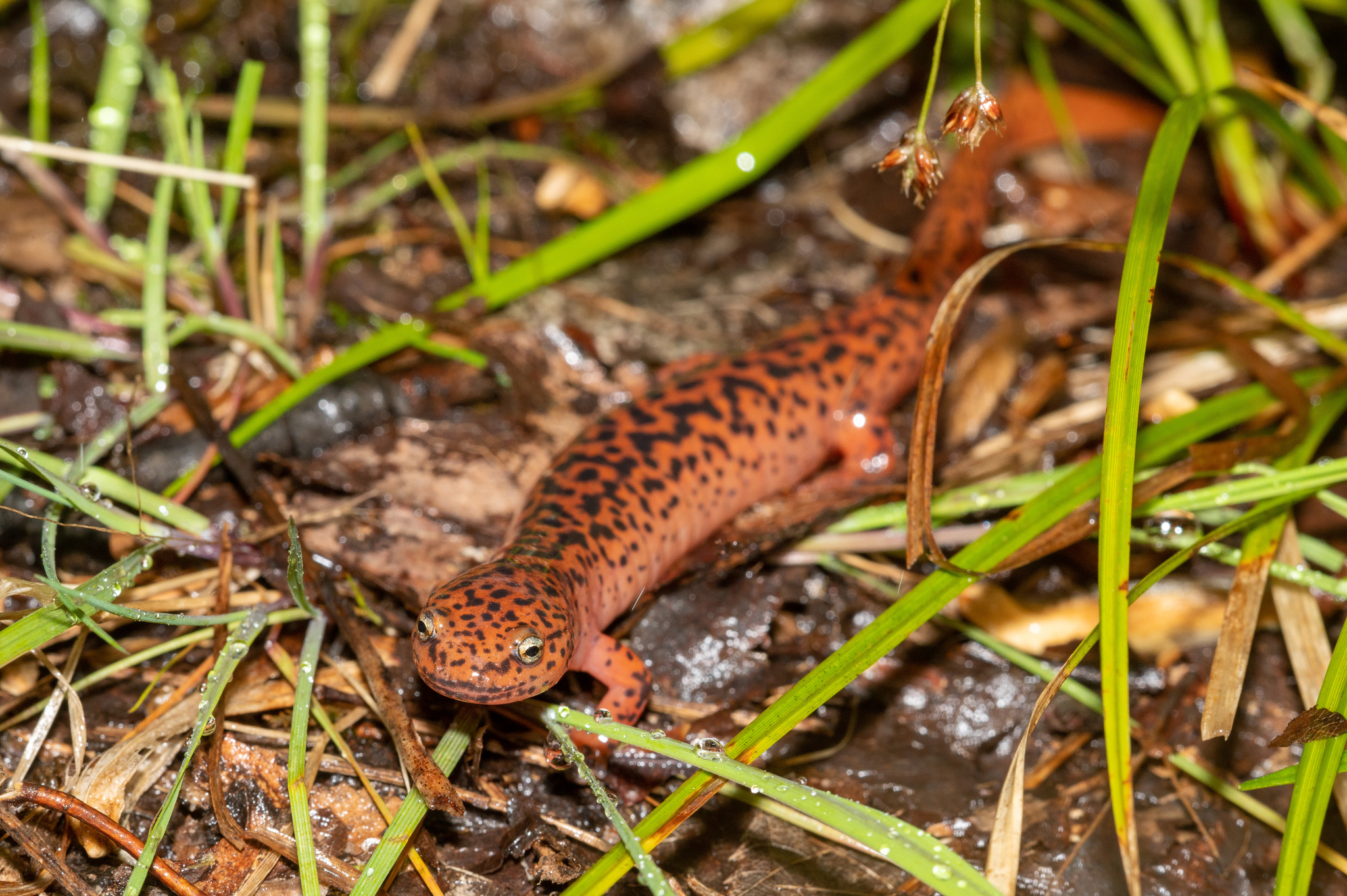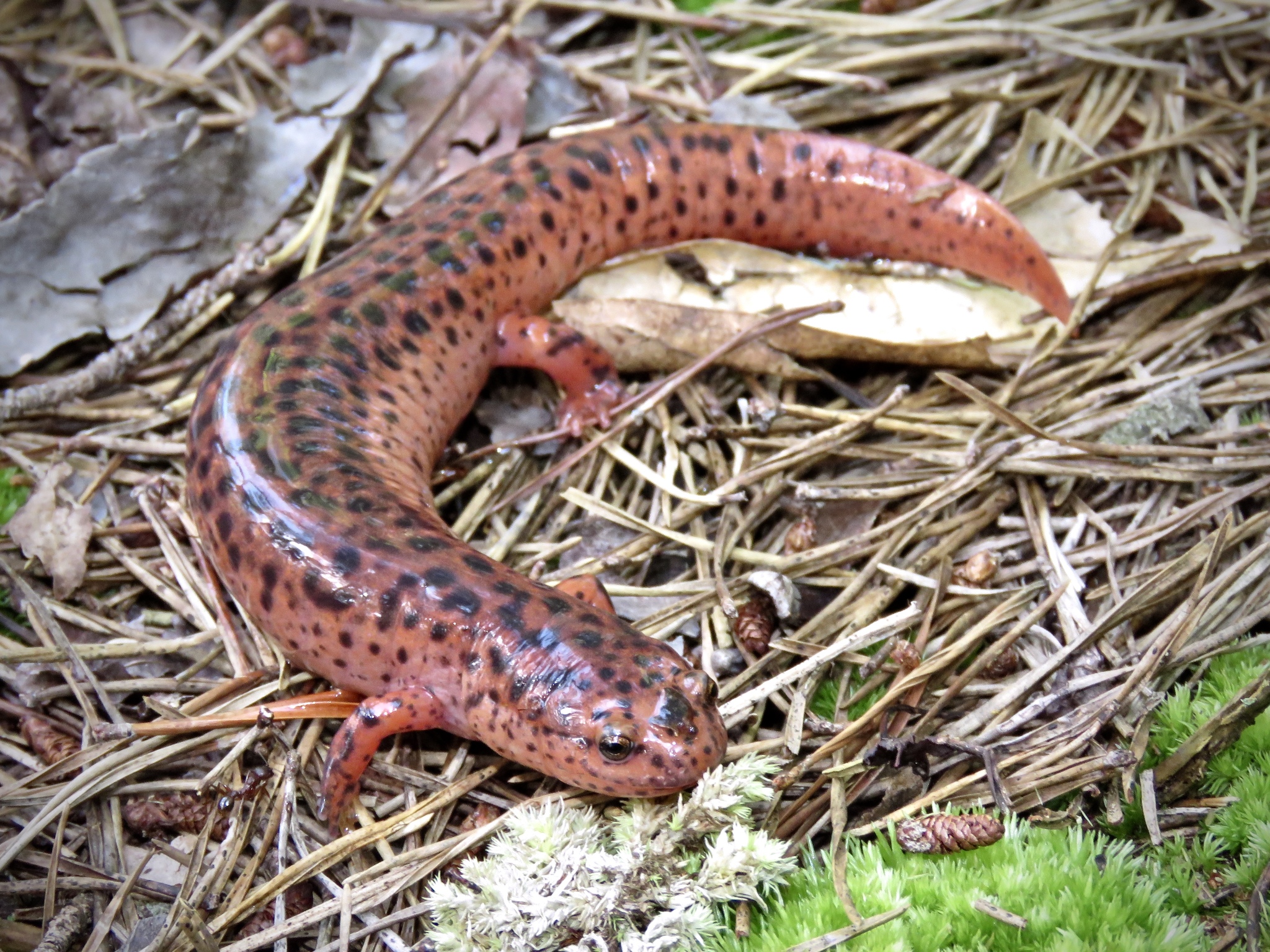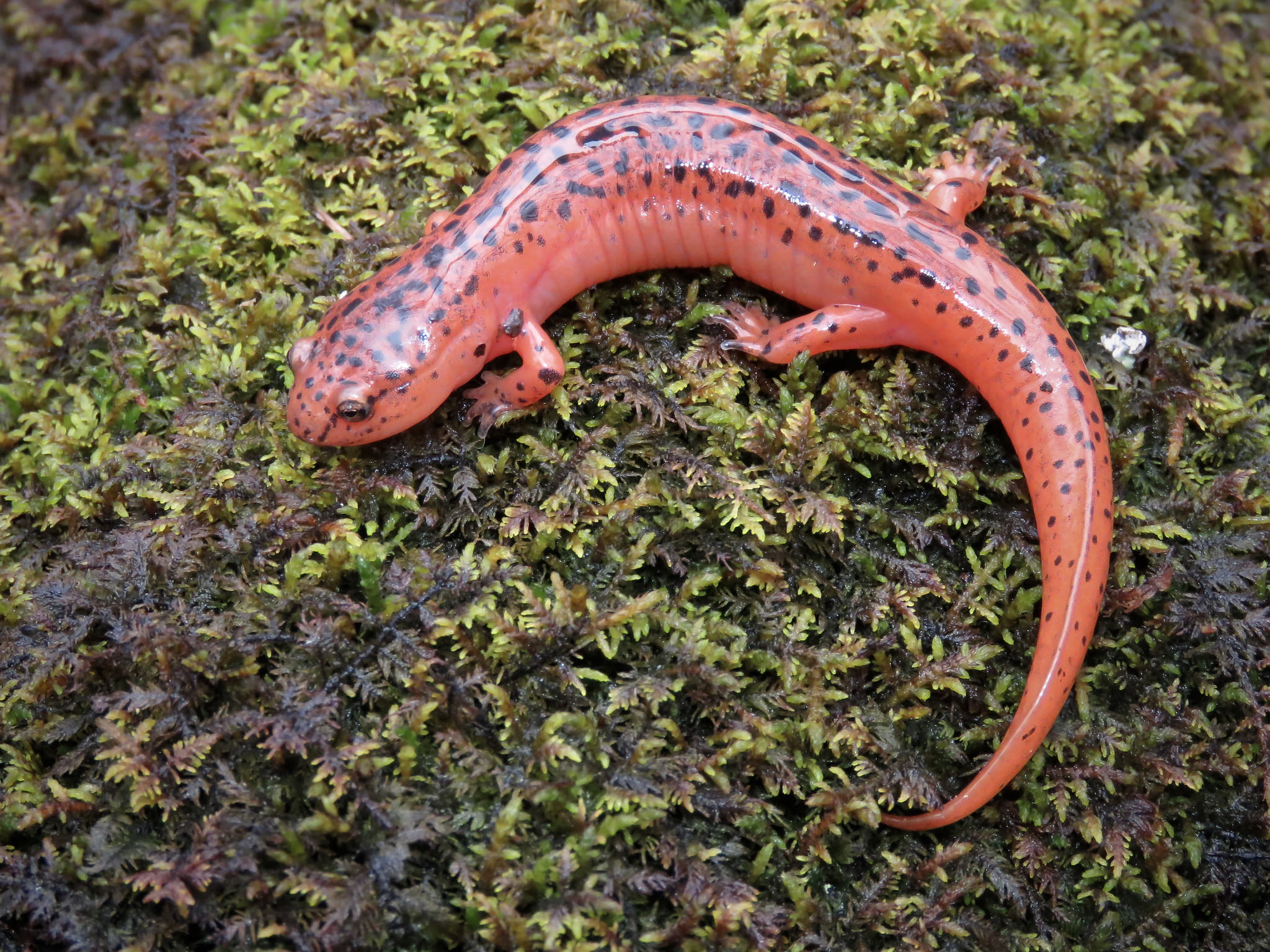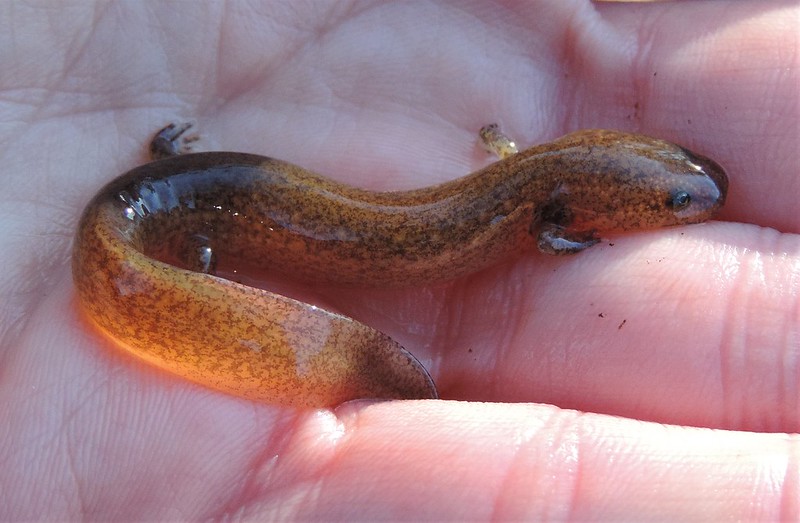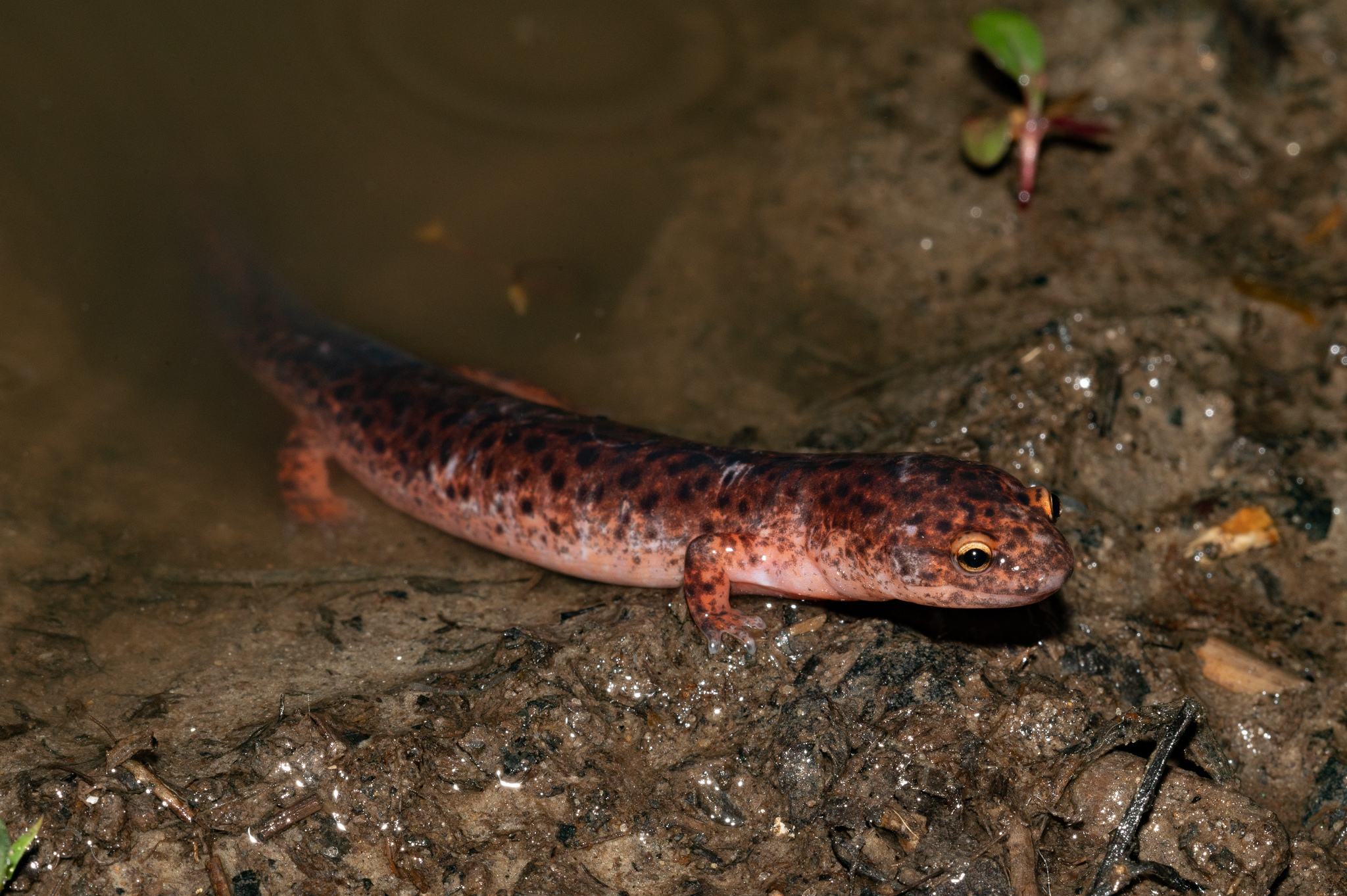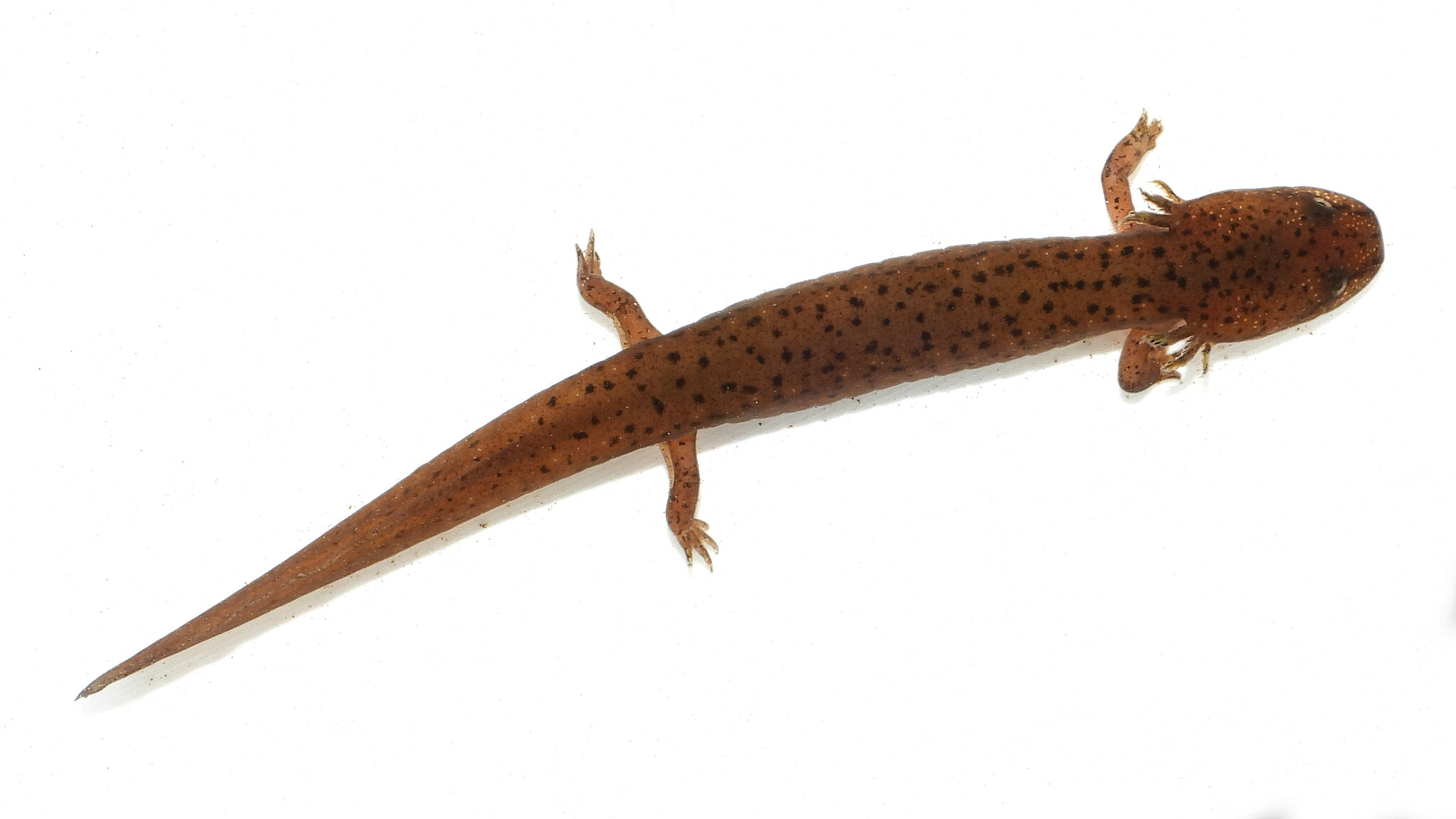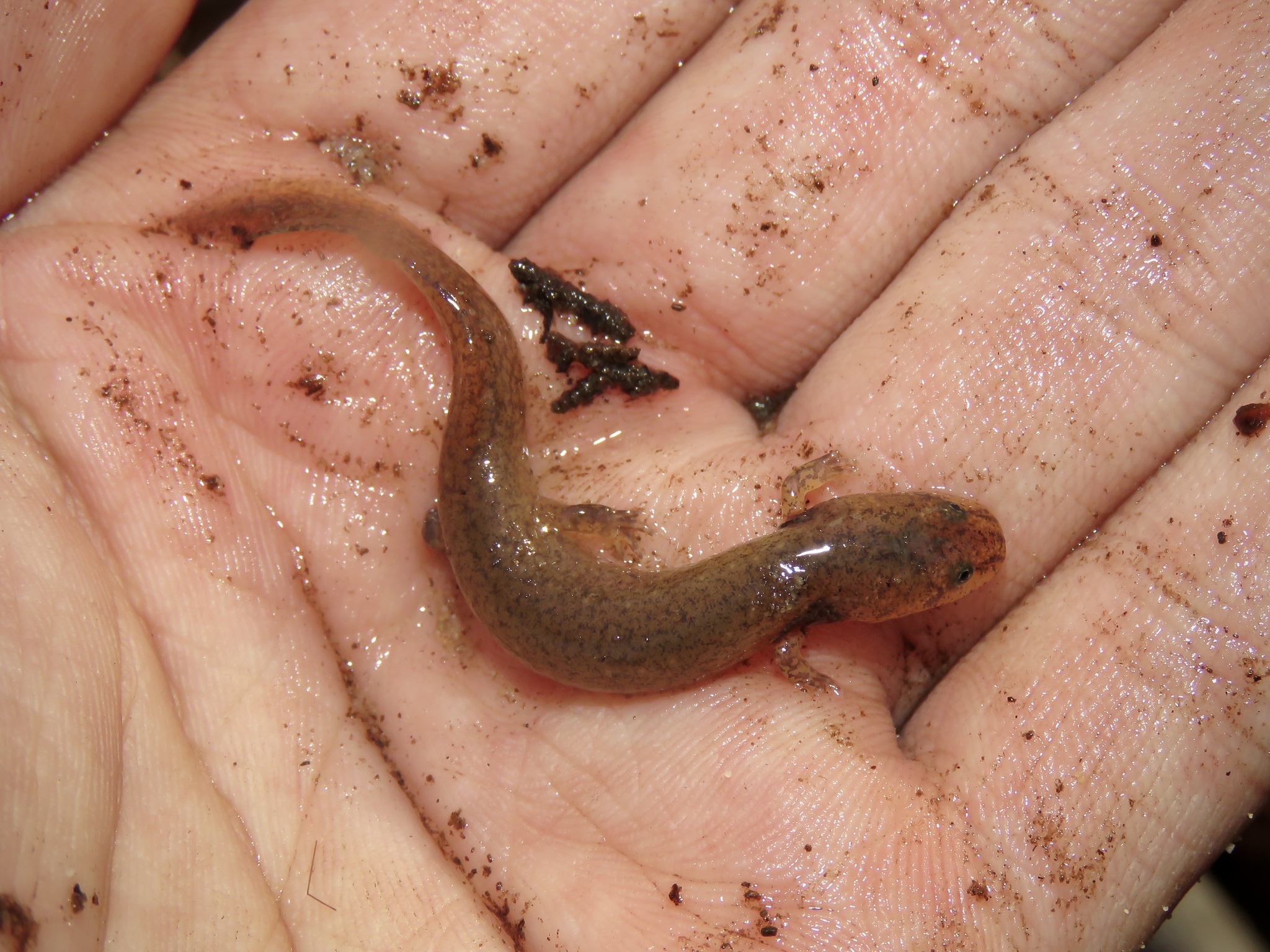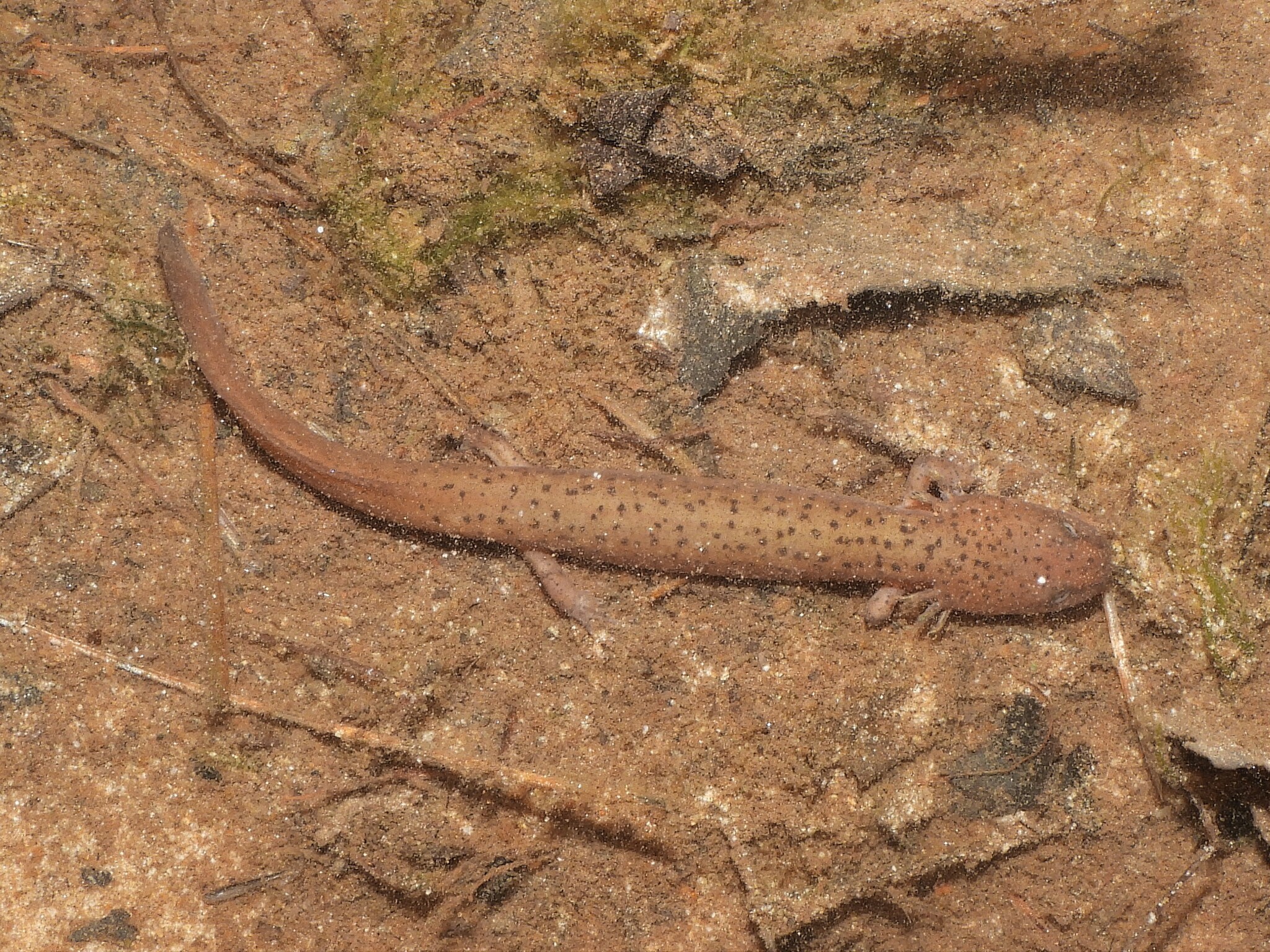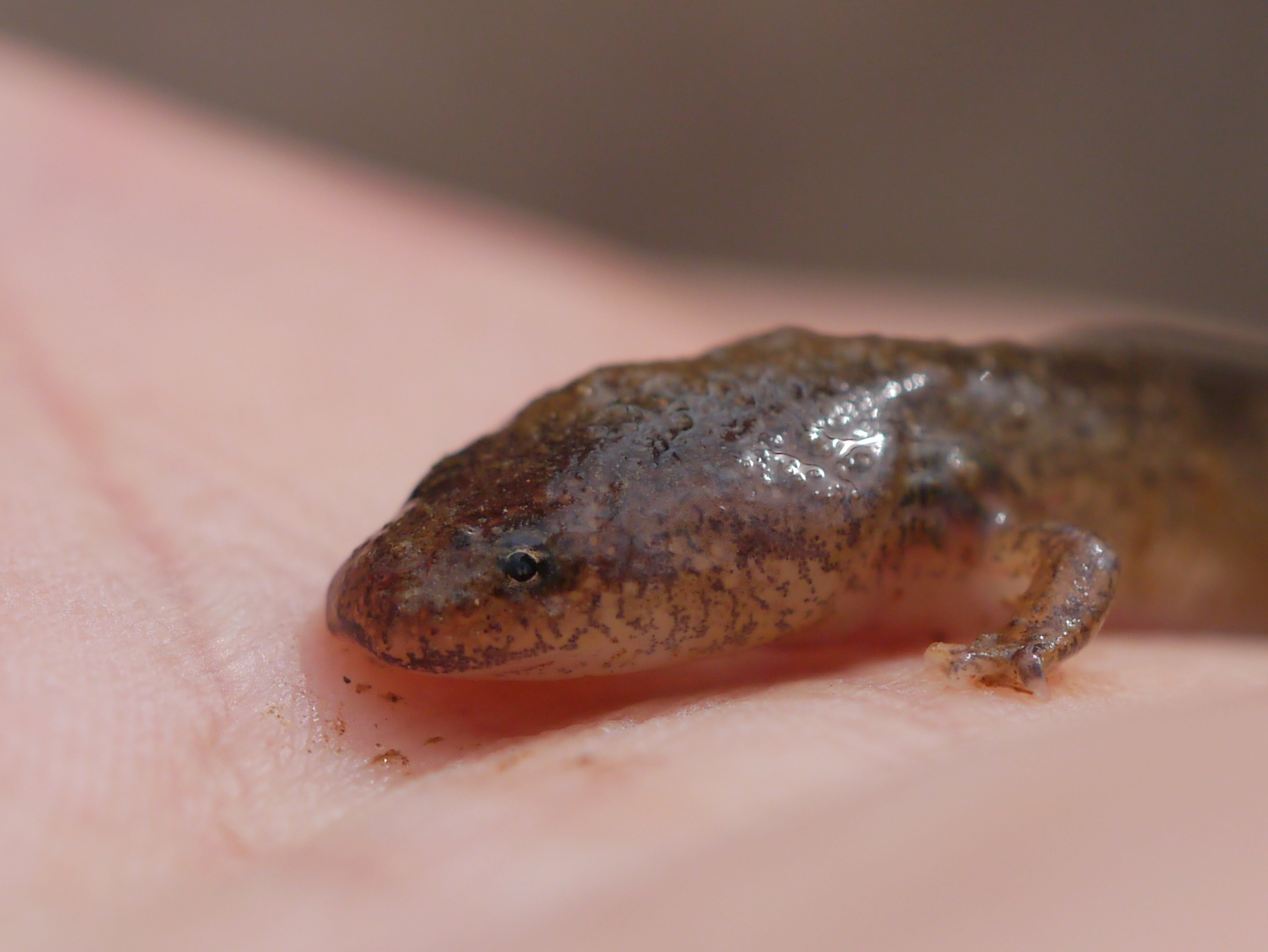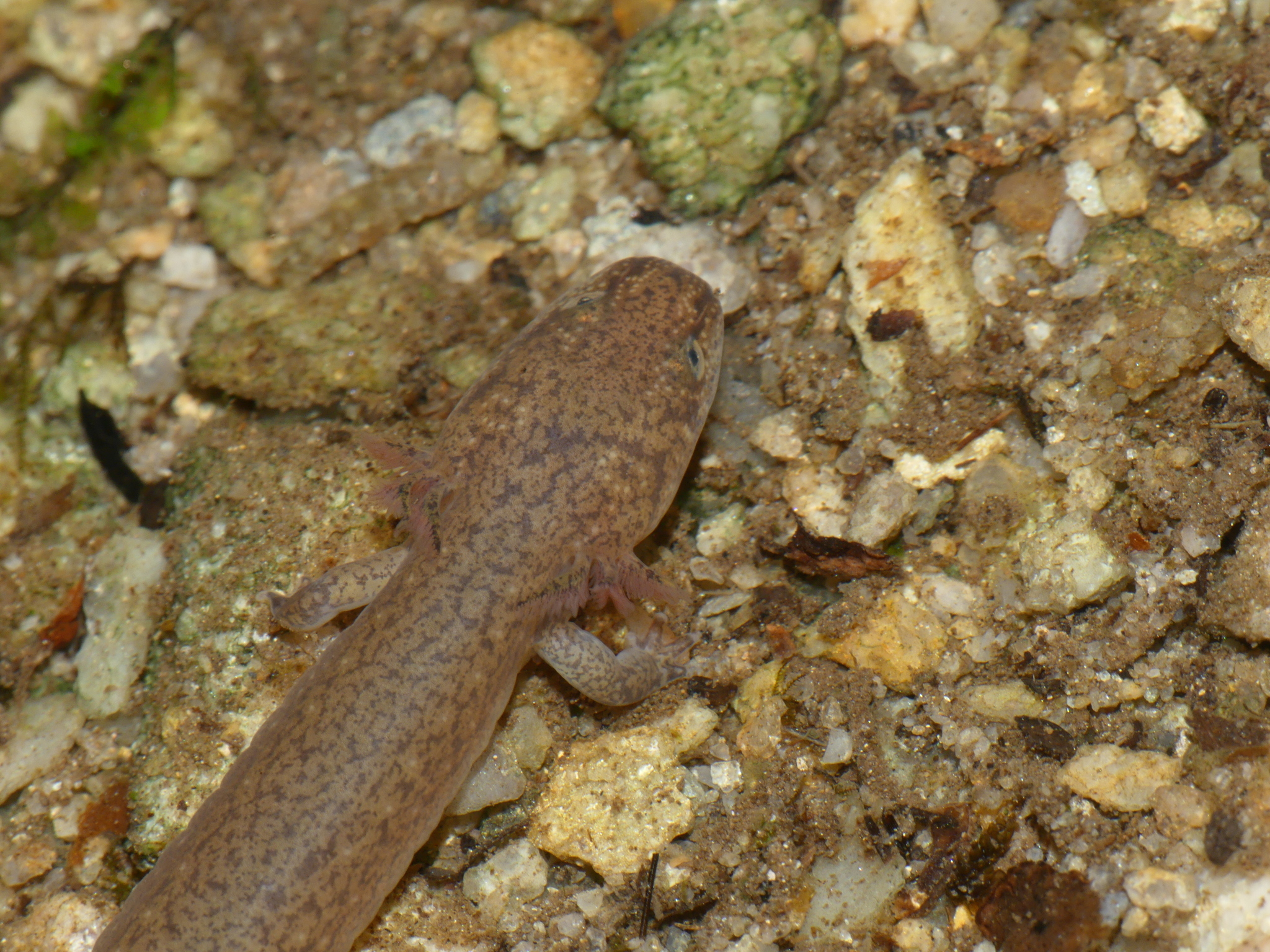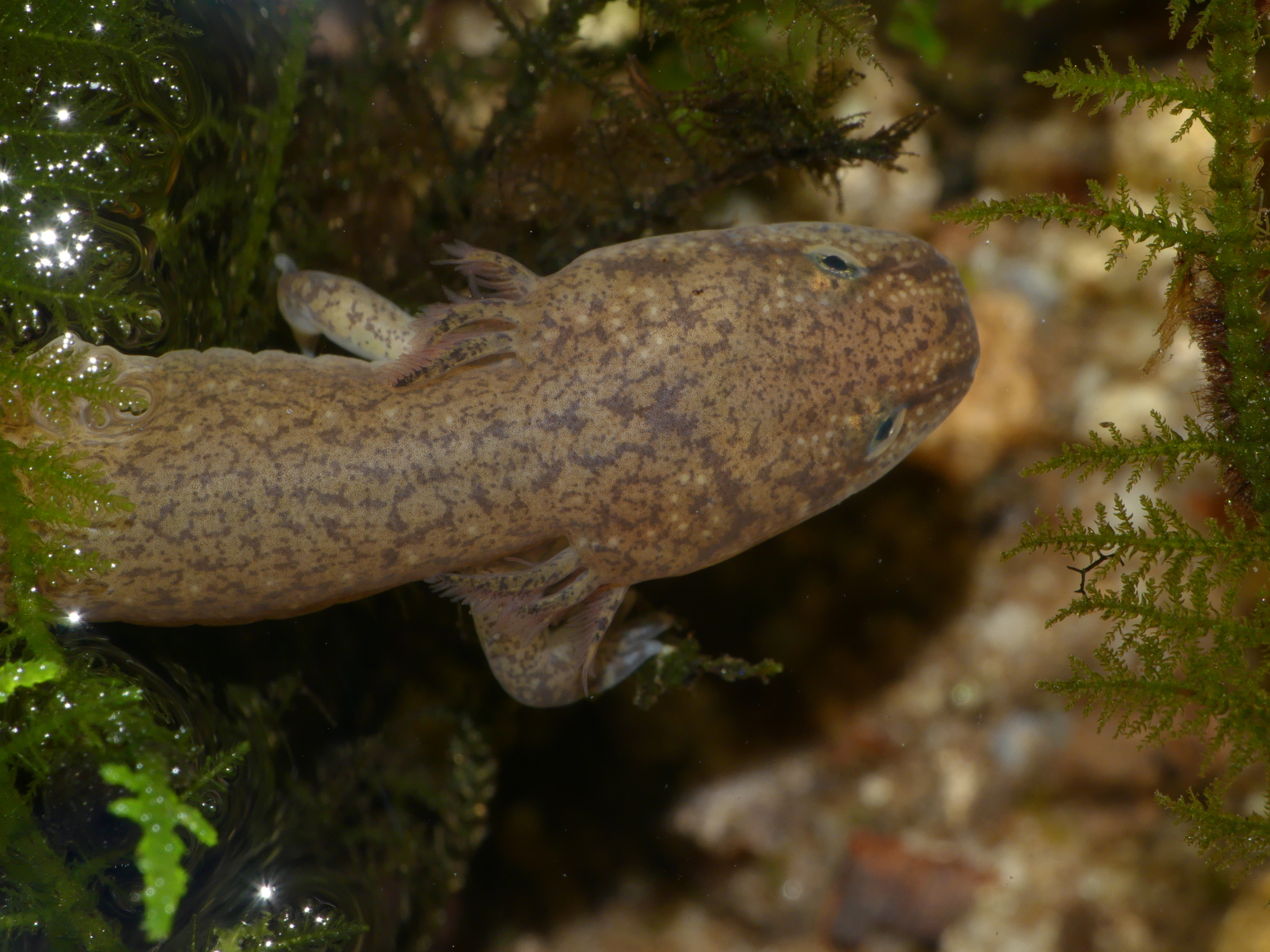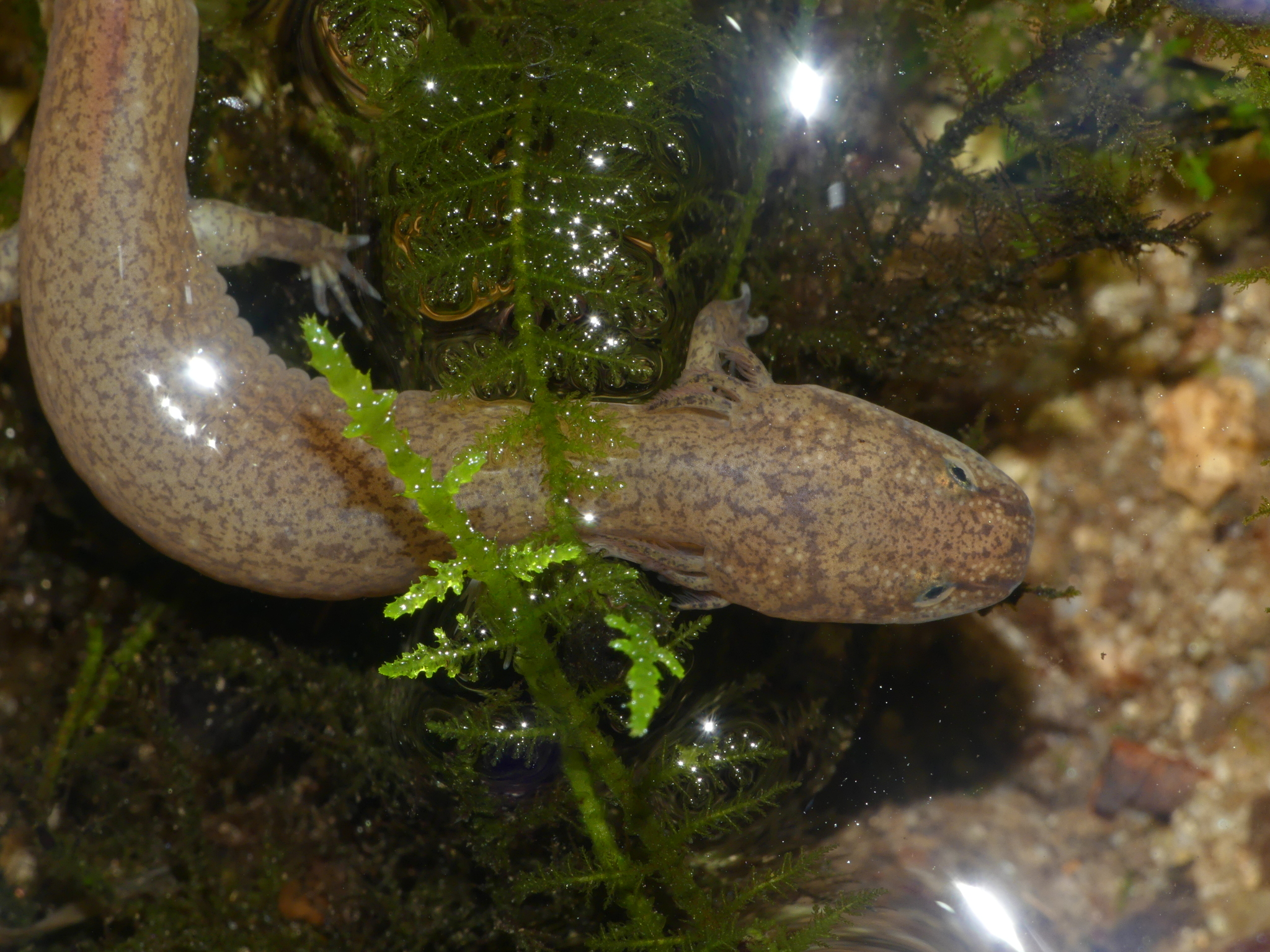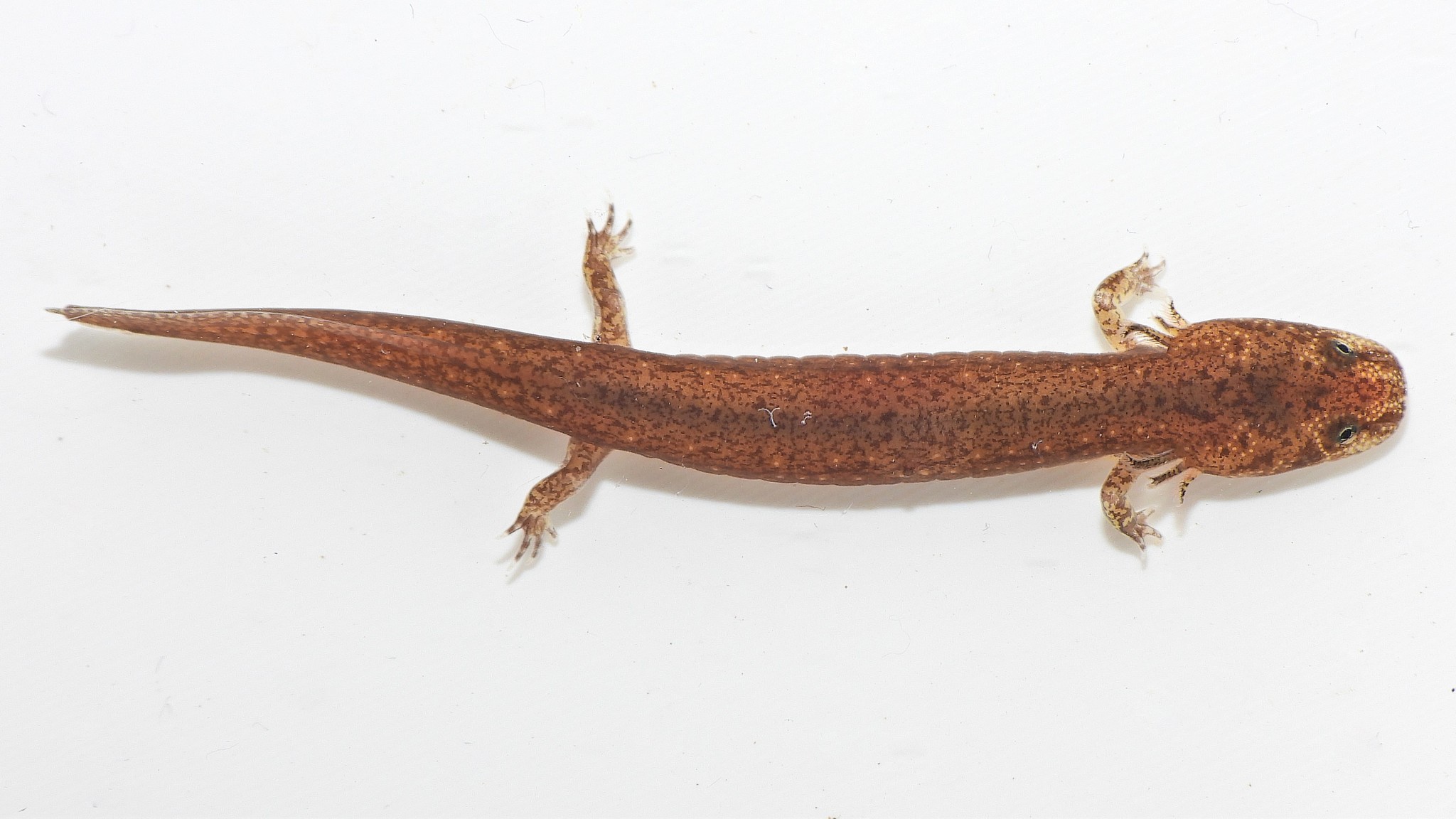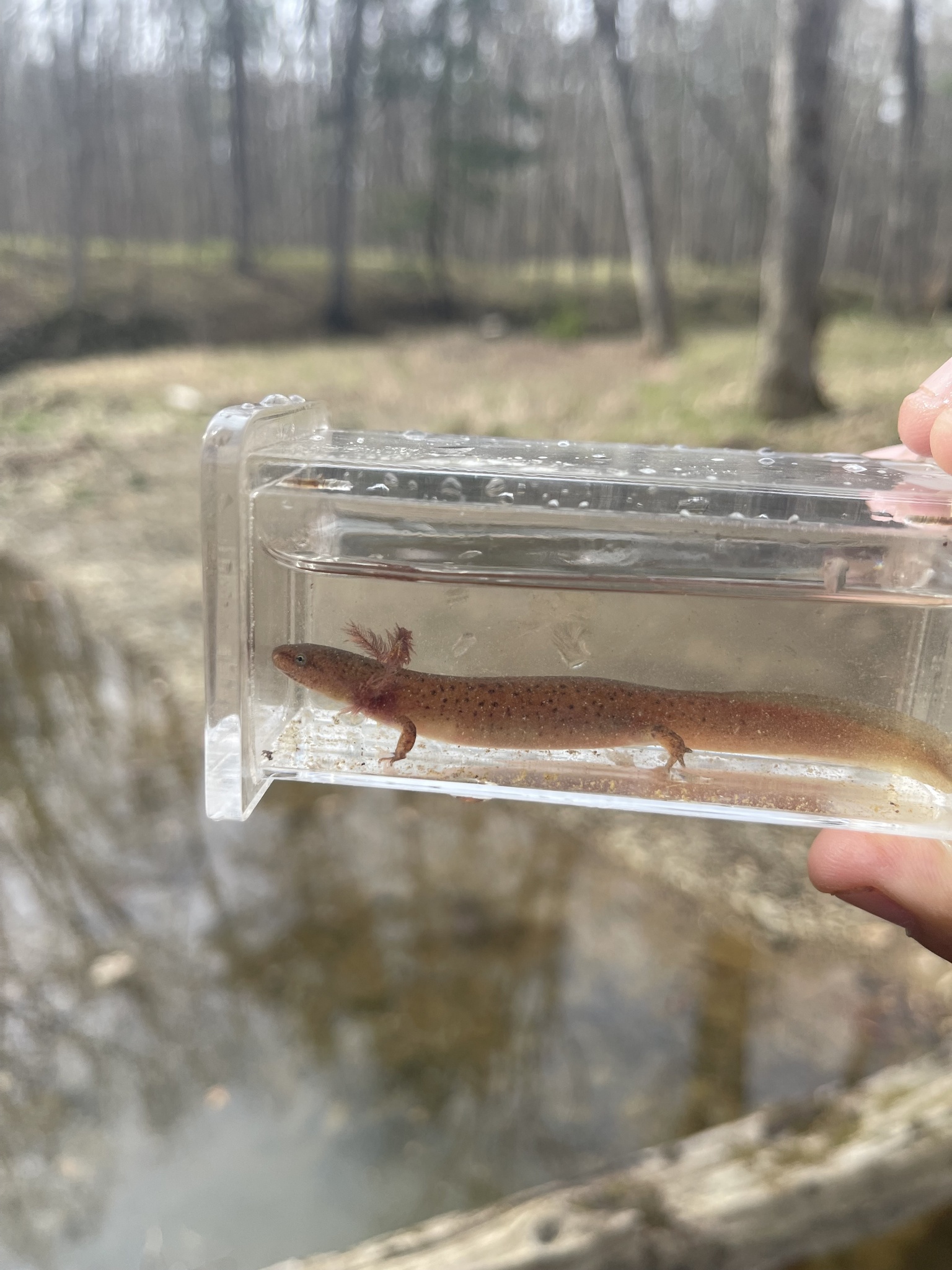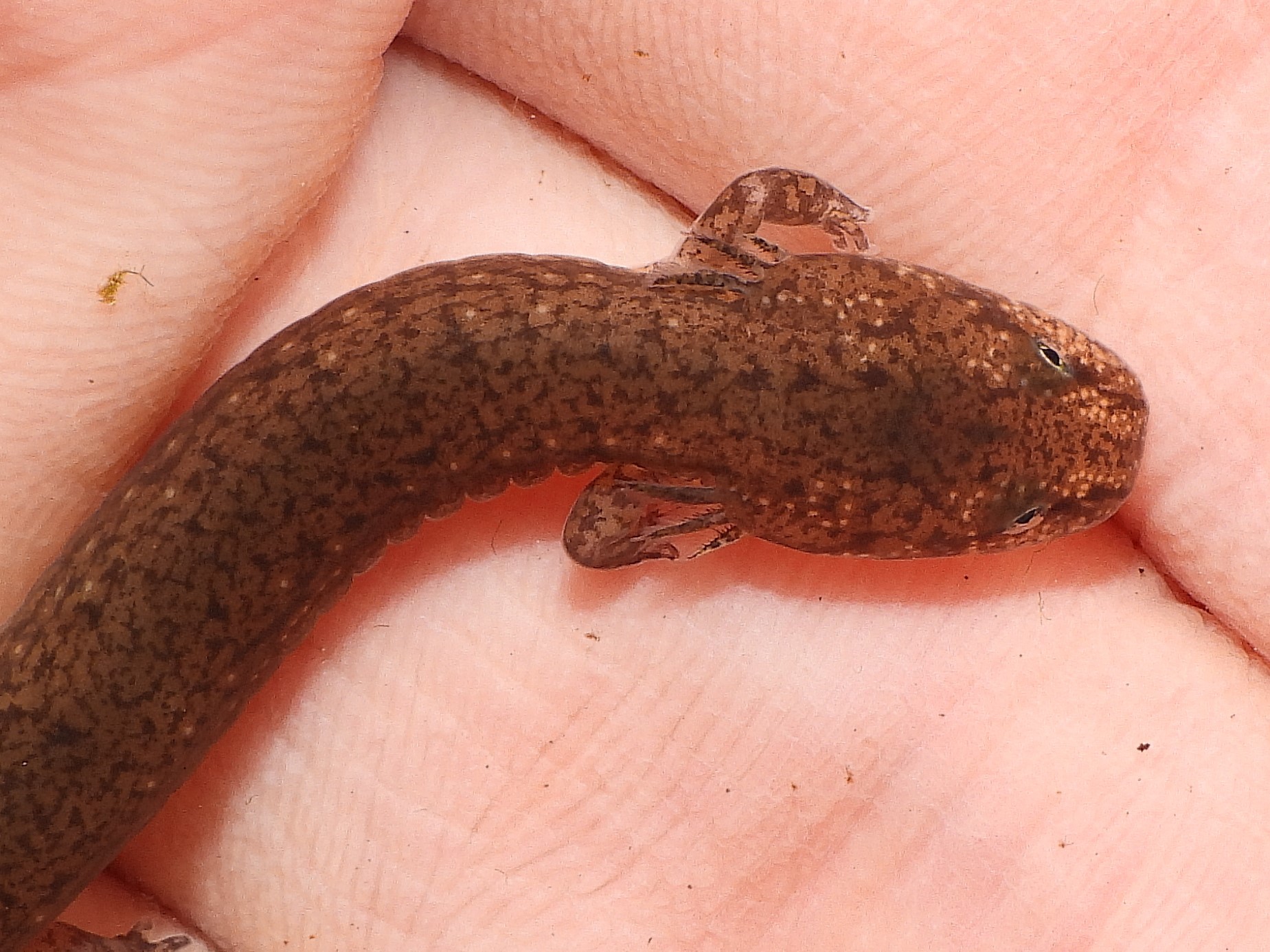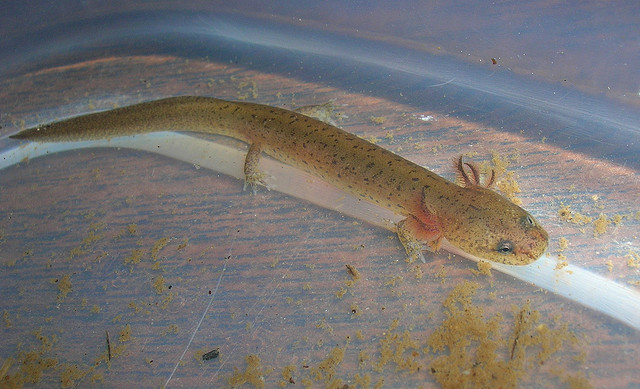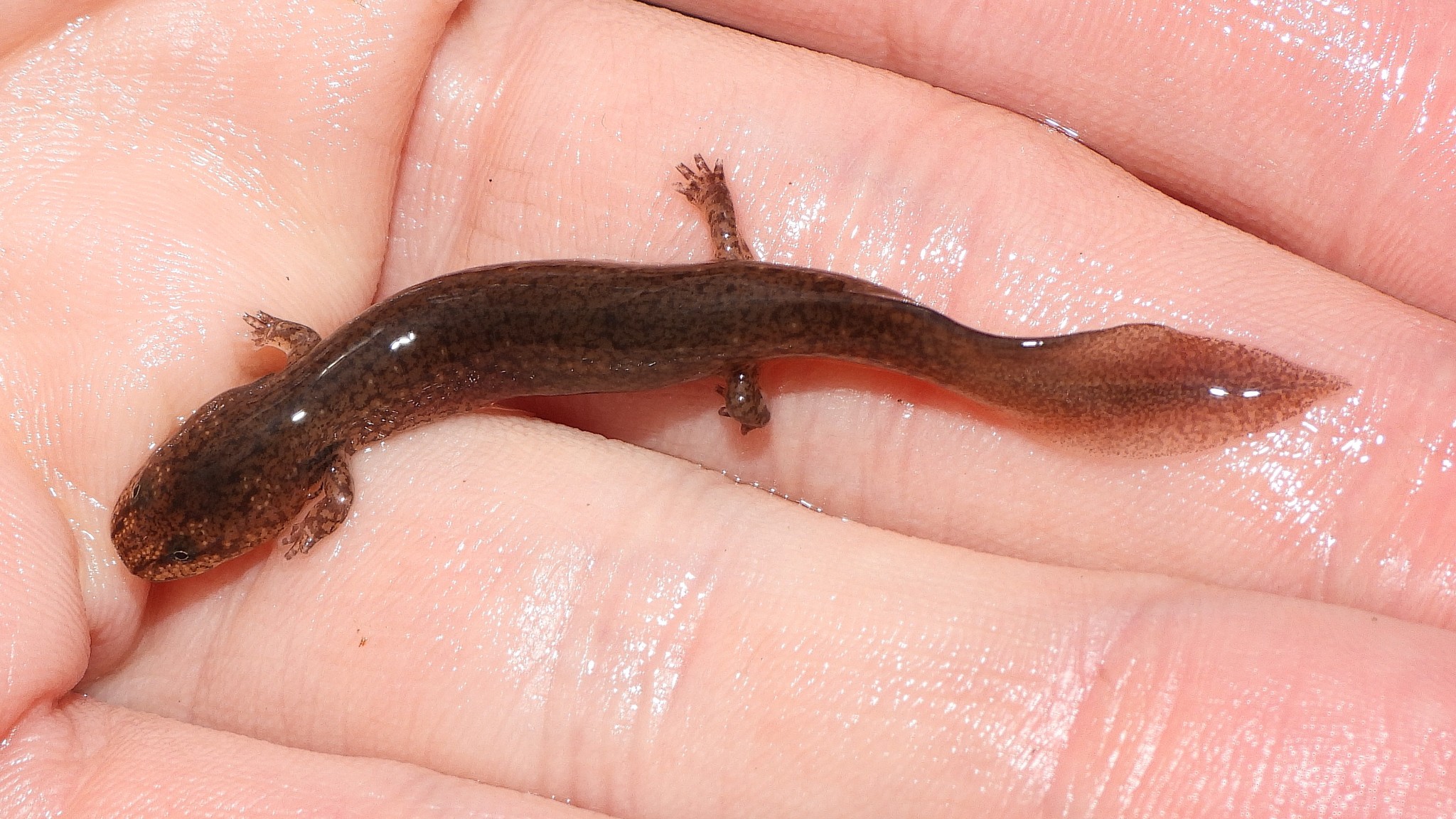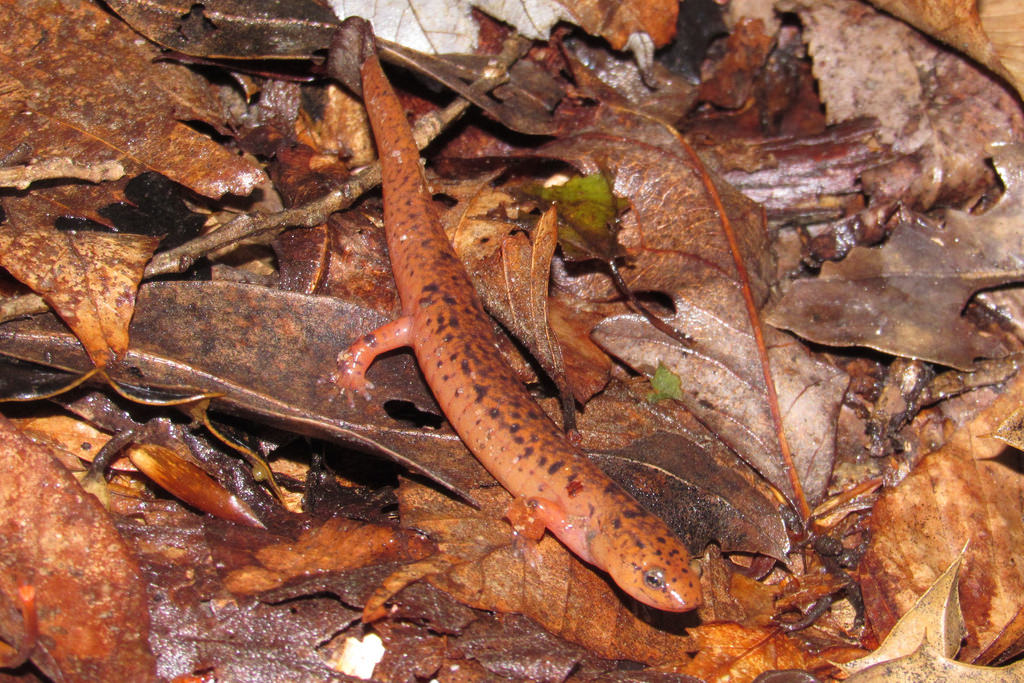Map Snapshot




















277 Records
Status
The Red Salamander (Pseudotriton ruber) is a large and sometimes brightly colored denizen of clear forested seeps and streams. This stocky salamander is a charismatic and showy creature to observe. Red Salamanders are present throughout Maryland except for the southern counties of the Eastern Shore. Adults vary from bright red, with black spots, to a more muted muddy brownish, especially in older individuals. Breeding takes place in seepy areas and along streams in spring or fall. Larvae are aquatic, and have conspicuous external gills (Conant & Collins, 1998; Maryland DNR site; Virginia Herpetological Society site).
Seasonality Snapshot
Source: Wikipedia
| Red salamander | |
|---|---|

| |
| Scientific classification | |
| Domain: | Eukaryota |
| Kingdom: | Animalia |
| Phylum: | Chordata |
| Class: | Amphibia |
| Order: | Urodela |
| Family: | Plethodontidae |
| Genus: | Pseudotriton |
| Species: | P. ruber
|
| Binomial name | |
| Pseudotriton ruber (Latreille, 1801)
| |
| Synonyms | |
The red salamander (Pseudotriton ruber) is a species of salamander in the family (Plethodontidae) (lungless salamanders) endemic to the eastern United States. Its skin is orange/red with random black spots. Its habitats are temperate forests, small creeks, ponds, forests, temperate shrubland, rivers, intermittent rivers, freshwater, trees springs. Overall this species is common and widespread,[1] but locally it has declined because of habitat loss and it is considered threatened in Indiana and New York.[2] Red salamanders eat insects, earthworms, spiders, small crustaceans, snails, and smaller salamanders. To eat, they extend their tongue to capture prey on the tip of it and retract it back into their mouths.[3] The red salamander, as a member of the family Plethodontidae (lungless salamanders) lacks lungs and respires through its skin.[4]
Description
[edit]Pseudotriton ruber is a medium-large salamander, with adults ranging from 4.3 to 7.1 in (11–18 cm) in total length. It has relatively stout bodies with 16–18 coastal grooved sides.[5] It is back that varies in color from an orange-brownish tint to a bright red, depending on its age. Like other salamanders, the red salamander seems to lose its color as it ages, becoming more darkly pigmented with less obscure patterns.[6] The larvae of this species have a stout head and body, dark in coloration, lack spots, and tend to have distinct mottling or streaks.[7] Another distinguishing characteristic of P. ruber is the appearance of numerous irregular black spots down its back. Although the red salamander is brilliantly colored and has many distinguishing features, it is sometimes difficult to tell species apart. P. ruber is most similar in appearance to the mud salamander (P. montanus), but can be distinguished by the difference in size and number of spots running down the dorsum and also by the difference in the color of the iris. Both P. ruber and P. montanus have bright red colorations that have been considered examples of a Müllerian mimetic complex.[8] The red salamander has more spots and the spots also tend to be larger in size than those of the mud salamander. In regard to eye color, the red salamander's iris is a gold-like tint, whereas the mud salamander's iris is brown.[2] The gold-like tint iris for the red salamander is also distinguished by its horizontal bar that runs through the iris.[9] Mud salamanders typically have a blunter snout than the red salamander.[6] Also, the mud salamanders typically have a more contrasting dorsal and ventral coloration than the red salamanders that are more uniform in color.[6]
Taxonomy
[edit]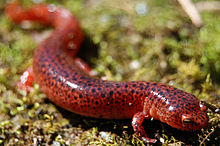
In the Plethodontidae (lungless salamanders), many members respire through their skin and the lining in their mouths. Lunglessness in this family may have evolved due to an adaptation for life in streams, and members of the family Plethodontidae probably did evolve other methods for respiration other than lungs (i.e. gills) due to enhanced survival of larval salamanders in fast-moving stream environments of southern Appalachia.[10][11] Lungs in general help aquatic animals maintain position in the water column, but the larvae of Plethodontidae members are benthic creatures, therefore the adaptation of lunglessness would be beneficial to them since buoyancy would endanger their survival.[11] The red salamander is further classified as a member of the genus Pseudotriton. Members of this genus include only the red salamander and the mud salamander.
Distribution
[edit]The four subspecies of P. ruber are found across the eastern United States, occupying streams through open areas such as fields and meadows and deciduous or mixed hardwood forests, especially near streams, seepages, and damp settings.[12] Red Salamanders are also found in deciduous or mixed hardwood forests, especially near streams, seepages, and damp settings Each subspecies is similar in appearance with slight differences in size and coloration, but are found in different habitats. The northern red salamander, P. r. ruber, is characterized as being red or reddish-orange with numerous black spots down its back. This subspecies is the most common and can be found from southern New York and Ohio to northeast Alabama, as well as the Upper Peninsula of Michigan.[6] Similar in appearance to the northern red salamander is the Blue Ridge red salamander, P. r. nitidus. This species differs it is slightly smaller and lacks black coloration on the tip of the tail and chin.[6] The Blue Ridge red salamander is found in elevations to more than 5,000 ft (1,500 m) in the southern part of the Blue Ridge Mountains of Virginia.[6] The blackchin red salamander, P. r. schencki, differs in appearance by having strong black coloration under its chin, as well as spotting all the way to the tip of the tail.[6] It can also be found in elevations to more than 5,000 ft (1,500 m) in the Blue Ridge Mountains.[6] The southern red salamander (P. r. vioscai) is often purplish- to salmon-colored and normally has white spots on its head. This subspecies is found from southern South Carolina to southeast Louisiana and southwest Kentucky. All subspecies of P. ruber occupy moist environments such as under moss and stones near clear water sources such as streams or springs.[6] Red salamanders are normally not found near large streams, but instead near smaller water sources.[13]
Ecology
[edit]
Some important aquatic and terrestrial ecological aspects of this salamander include its diet, predators, and microhabitat preferences. Larvae mainly feed on invertebrates such as insect larvae and worms.[14] Larvae diet specifically has been shown to consist of Chironomidae (36.52% of prey items) and Sphaeriidae (15.17%) as well as terrestrial prey (7.87%) and other salamanders.[15] Larval growth rates differ depending on the temperature of the water and tend to be higher in the warmer months when water temperature is higher.[13][16] The red salamander generally lays eggs in the fall and hatching season takes place in the late fall and winter.[16] The larval period varies between 27 and 31 months and then metamorphosis takes place in the spring and early summer of the third year.[16] The larvae go through metamorphosis after a few weeks or months, depending on the environmental conditions.[17] Larval red salamanders are generalists, eating whatever is available.[18] The rates typically increase when water temperature is low and larger individuals feed more than smaller individuals.[18] Although feeding rates appear to increase with increasing size, mortality rates, though, seem to be independent of size or age and survival is estimated to be about 50% per year.[16] The longer larval period ensures that transformation occurs when the salamanders are much larger than other species of salamanders and typically have a short juvenile period, maturing quickly.[13] Larval duration and size at metamorphosis decrease with increasing elevation.[19] Males mature at about 53–63 mm (2.1–2.5 in), typically at four years of age, and females mature at about 55–68 mm (2.2–2.7 in), typically at about five years of age.[13]
Red salamanders generally live in springs or streams during the winter and then disperse to and from these sites in the fall and spring.[20] Due to its semiaquatic nature, the red salamander remains in terrestrial environments until early spring then disperses to more aquatic sites.[13] Adults often live in burrows along streams and in other moist environments such as under logs and rocks along the forest floor.[14] Adult red salamanders, like their larvae, are generalists and tend to feed on invertebrates (such as earthworms, slugs, snails, spiders, diving beetles and other insects),[21] as well as small amphibians,[14] including the red-backed salamander.[21] Its predators include birds and small carnivores such as skunks and raccoons.[13] Since the red salamander is a large species of salamander, its presence or absence can greatly affect the ecosystem where it lives, and understanding its ecology is important to understand its role in community structures.
Life history
[edit]P. ruber has a wide range in its breeding season, which is only limited by extremely cold temperatures.[13] Adults are known to migrate from streams and bodies of water to terrestrial habitats during specific seasons each year. They will then return to aquatic streams in the late summer and early fall to begin breeding.[22] Generally, however, adult red salamanders mate annually and engage in primitive courting activities.[20][23] Courtship between two red salamanders involves:
"A male approaches a female, rubbing his snout against her snout, cheeks, and chin. The male then moves his head and body under her chin and starts tail undulations. The female then straddles the male's tail and the pair engages in a straddled 'walk' until the male deposits sperm on the substrate. The 'straddle-walk' approximately lasts two minutes and once the sperm is deposited, the female picks up the sperm cap as she moves over it and then they separate."[23]
Females are capable of long-term sperm storage and may not lay eggs for months after mating.[13] Females typically lay eggs in the fall or early winter in headwater streams, have very well-hidden nests.[14] The eggs are usually placed in clusters and cling to submerged plants or other objects.[24]
Based on presence of scars and hypertrophied jaws in mature males, it is suggested that male P. ruber might be involved in mate-guarding behavior.[25] Males occasionally court other males as a means of sperm competition to get the other male to deposit spermatophores, giving them a better chance of successful mating over their competitors.[23]
Other important behavioral aspects of P. ruber include its defensive mechanisms. When threatened, red salamanders assume a defensive posture in which they curl their bodies, elevating and extending their rears, and placing their heads under their tails which are elevated and undulated from side to side.[26] The coloration of the red salamander has been hypothesized to mimic that of the red eft stage of the eastern newt (Notophythalmus viridescens) which emits a powerful neurotoxin in their skin.[27] This phenomenon is known as the Mullerian Mimicry Complex.[28] However, this hypothesis was heavily criticized due to significant size differences in the organisms and the differences in the species' times of foraging ( i.e. P. ruber mainly at night and the red eft mainly during the day).[29] More recently, red salamanders have been noted to have reduced palatability, so they are considered part of a Müllerian mimicry system in which all species are unpalatable and benefit from aposematic coloration.[13] In human trials, subjects reported no noxious or repulsive taste of Red Salamanders.[30] P. ruber possesses pseudotritontoxin that has adverse effects on mice including: hypertension of hind legs and lower back, irritability, hypothermia, coma, and death within 12-48 hours. [31]
Conservation
[edit]Overall the red salamander is common and widespread,[1] but locally it has declined because of habitat loss and it is listed as an endangered species in Indiana.[32]
The red salamander is arguably one of the most primitive plethodontids, so is extremely valuable in understanding the links to ancestors and the evolutionary processes that have occurred.[23] Maintaining species diversity is an important part of conservation, and to prevent the loss of salamander diversity as a whole, it is important to have some type of management plan in place to prevent P. ruber from escalating from a low conservation status to a higher level of concern. Since the red salamander prefers streams that are relatively pure, it is important to monitor human waste and pollution, since debris and silt could have adverse effects on their habitat, potentially causing a threat to survival.
References
[edit]- ^ a b c IUCN SSC Amphibian Specialist Group (2014). "Pseudotriton ruber". IUCN Red List of Threatened Species. 2014: e.T59404A56253351. doi:10.2305/IUCN.UK.2014-1.RLTS.T59404A56253351.en. Retrieved 12 November 2021.
- ^ a b Red salamander(Pseudotriton ruber).Savannah River Ecology Laboratory: Herpetology Program.1 April 2011 http://www.uga.edu/srelherp/salamanders/pserub.htm.
- ^ Marvin, Glenn; Paul, Cupp (2018). "Chemical Detection of Intraguild Predators (Gyrinophilus, Pseudotriton) by Streamside Plethodontid Salamanders (Eurycea)". Southeastern Naturalist. 17 (1): 166–175. doi:10.1656/058.017.0117. S2CID 91078114.
- ^ Miller, R. (2016). "Pseudotriton ruber". Animal Diversity Web. Retrieved 15 March 2017.
- ^ Martof, Bernard S.; Francis, Rose L. (1962). "The comparative osteology of the anterior cranial elements of the salamanders Gyrinophilus and Pseudotriton". Copeia. 727–732.
- ^ a b c d e f g h i Conant, R. and J.T. Collins.Peterson Field Guides: Reptiles and Amphibians.New York: Houghton Mifflin, 1998.[page needed]
- ^ Martof, Bernard S. (1975). "Pseudotriton ruber". Catalogue of American Amphibians and Reptiles: 167.2. doi:10.15781/T23X83Q9B. hdl:2152/45094.
- ^ Pierson, Todd W.; Blake-Sinclair, Jasmyne; Holt, Benjamin (2022-05-27). "Molecular Identification of an Avian Predator of Mimetic Salamanders". Southeastern Naturalist. 21 (2). doi:10.1656/058.021.0203. ISSN 1528-7092. S2CID 249140575.
- ^ Folt, Brian; Garrison, Nicole; Guyer, Craig; Rodriguez, Juanita; Bond, Jason E. (May 2016). "Phylogeography and evolution of the Red Salamander (Pseudotriton ruber)". Molecular Phylogenetics and Evolution. 98: 97–110. Bibcode:2016MolPE..98...97F. doi:10.1016/j.ympev.2016.01.016. PMID 26872531.
- ^ Wilder, I.W.; Dunn, E.R. (1920). "The correlation of lunglessness in salamanders with a mountain brook habitat". Copeia. 84: 63–68.
- ^ a b Beachy, Christopher King; Bruce, Richard C. (April 1992). "Lunglessness in Plethodontid Salamanders is Consistent with the Hypothesis of a Mountain Stream Origin: A Response to Ruben and Boucot". The American Naturalist. 139 (4): 839–847. doi:10.1086/285360. S2CID 83564451.
- ^ Folt, Brian; et al. (2016). "Phylogeography and evolution of the Red Salamander (Pseudotriton ruber)". Molecular Phylogenetics and Evolution. 98: 97–110. Bibcode:2016MolPE..98...97F. doi:10.1016/j.ympev.2016.01.016. PMID 26872531.
- ^ a b c d e f g h i Petranka, J.W. Salamanders of the United States and Canada. Washington and London: Smithsonian Institution Press, 1998.[page needed]
- ^ a b c d Bishop, Sherman C (1941). The Salamanders of New York. Museum bulletin (New York State Museum), no. 324. The University of the State of New York. OCLC 2055347.[page needed]
- ^ Cecala, Kristen K.; Price, Steven J.; Dorcas, Michael E. (December 2007). "Diet of Larval Red Salamanders (Pseudotriton Ruber) Examined Using a Nonlethal Technique". Journal of Herpetology. 41 (4): 741–745. doi:10.1670/07-019.1. ISSN 0022-1511. S2CID 53067584.
- ^ a b c d Bruce, Richard C. (1972). "The Larval Life of the Red Salamander, Pseudotriton ruber". Journal of Herpetology. 6 (1): 43–51. doi:10.2307/1563093. JSTOR 1563093.
- ^ Wang, Kenneth; et al. (2023). ""An evaluation of sexual dimorphism in head size and shape in Red Salamanders (Pseudotriton ruber)."". Reptiles and Amphibians 30.1. 30: e18211. doi:10.17161/randa.v30i1.18211.
- ^ a b Cecala, Kristen K.; Price, Steven J.; Dorcas, Michael E. (2007). "Diet of Larval Red Salamanders (Pseudotriton ruber) Examined Using a Nonlethal Technique". Journal of Herpetology. 41 (4): 741–745. doi:10.1670/07-019.1. JSTOR 40060469. S2CID 53067584.
- ^ Semlitsch, Raymond D. (1983). "Growth and Metamorphosis of Larval Red Salamanders (Pseudotriton ruber) on the Coastal Plain of South Carolina". Herpetologica. 39 (1): 48–52. JSTOR 3892475.
- ^ a b Bruce, Richard C. (1978). "Reproductive Biology of the Salamander Pseudotriton ruber in the Southern Blue Ridge Mountains". Copeia. 1978 (3): 417–423. doi:10.2307/1443605. JSTOR 1443605.
- ^ a b "Pseudotriton ruber (Red Salamander)". Animal Diversity Web.
- ^ Duellman, W. E. (2006). [Review of Amphibian Declines: The Conservation Status of United States Species, by M. Lanoo]. Great Plains Research, 16(1), 101–102. http://www.jstor.org/stable/23779737
- ^ a b c d Organ, James A.; Organ, Della J. (1968). "Courtship Behavior of the Red Salamander, Pseudotriton ruber". Copeia. 1968 (2): 217–223. doi:10.2307/1441744. JSTOR 1441744.
- ^ Bruce, Richard, C (1978). ""Reproductive biology of the salamander Pseudotriton ruber in the southern Blue Ridge Mountains."". Copeia (3): 417–423. doi:10.2307/1443605. JSTOR 1443605.
{{cite journal}}: CS1 maint: multiple names: authors list (link) - ^ Wang, Kenneth; Brandon, Tyshiona; McDonald, Kelly-Ann; Pierson, Todd (2023-03-14). "An evaluation of sexual dimorphism in head size and shape of Red Salamanders (Pseudotriton ruber)". Reptiles & Amphibians. 30 (1): e18211. doi:10.17161/randa.v30i1.18211. ISSN 2332-4961. S2CID 257579622.
- ^ Brandon, Ronald A.; Labanick, George M.; Huheey, James E. (1979). "Relative Palatability, Defensive Behavior, and Mimetic Relationships of Red Salamanders (Pseudotriton ruber), Mud Salamanders (Pseudotriton montanus), and Red Efts (Notophthalmus viridescens)". Herpetologica. 35 (4): 289–303. JSTOR 3891961.
- ^ Howard, Ronnie R.; Brodie, Edmund D. (September 1971). "Experimental Study of Mimicry in Salamanders involving Notophthalmus viridescens viridescens and Pseudotriton ruber schencki". Nature. 233 (5317): 277. Bibcode:1971Natur.233..277H. doi:10.1038/233277a0. PMID 16063321. S2CID 4151201.
- ^ Folt, Brian; Garrison, Nicole; Guyer, Craig; Rodriguez, Juanita; Bond, Jason E. (1 May 2016). "Phylogeography and evolution of the Red Salamander (Pseudotriton ruber)". Molecular Phylogenetics and Evolution. 98: 97–110. Bibcode:2016MolPE..98...97F. doi:10.1016/j.ympev.2016.01.016. PMID 26872531.
- ^ Brandon, Ronald A.; Huheey, James E. (1975). "Diurnal Activity, Avian Predation, and the Question of Warning Coloration and Cryptic Coloration in Salamanders". Herpetologica. 31 (3): 252–255. JSTOR 3891585.
- ^ Brandon, Ronald A.; Labanick, George M.; Huheey, James E. (1979). "Relative Palatability, Defensive Behavior, and Mimetic Relationships of Red Salamanders (Pseudotriton ruber), Mud Salamanders (Pseudotriton montanus), and Red Efts (Notophthalmus viridescens)". Herpetologica. 35 (4): 289–303. ISSN 0018-0831. JSTOR 3891961.
- ^ Brandon, Ronald A.; Huheey, James E. (January 1981). "Toxicity in the plethodontid salamanders Pseudotriton ruber and Pseudotriton montanus (Amphibia, Caudata)". Toxicon. 19 (1): 25–31. Bibcode:1981Txcn...19...25B. doi:10.1016/0041-0101(81)90114-8. ISSN 0041-0101.
- ^ Indiana Legislative Services Agency (2011), "312 IAC 9-5-4: Endangered species of reptiles and amphibians", Indiana Administrative Code, retrieved 28 Apr 2012

